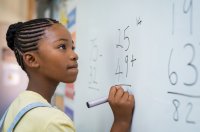Encouraging Students’ Independence in Math
Including emotion regulation activities in math lessons can help elementary students learn the content more effectively.
Your content has been saved!
Go to My Saved Content.Have you ever poured your heart into preparing and teaching a lesson only to have most students raise their hand for help as soon as you asked them to work independently?
Math can evoke powerful emotions, such as embarrassment, anxiety, and apathy. At the beginning of my career, I failed to recognize the impact these feelings had on my elementary students’ learning. My teaching wasn’t helping them become critical thinkers, problem solvers, or self-managers. So I refocused my efforts on developing my students’ ability to regulate their emotions, thoughts, and behaviors in class by adding management components to our daily routines.
Helping Students Improve Their Self-Management
Use a predictable, student-centered lesson structure: I wanted to allow my students opportunities during lessons to reason about the mathematics they were learning and guide them to develop critical thinking and problem-solving skills. I began structuring my lessons with four parts: a warm-up with some daily fluency practice, a launch problem (typically a word problem that would connect the previous day’s learning to the current day’s), exploration time, and a closing.
The four components of each lesson helped emphasize the importance of reasoning and making sense of math, culminating with a daily exit ticket that exemplified the lesson’s objective. As my students became familiar with this structure, they quickly learned that I expected them to do much of the thinking and speaking during each lesson.
The predictable nature of the lessons combined with the consistent expectations for student participation helped alleviate students’ stress.
Incorporate strategies for emotion regulation: Math anxiety—fear of making mistakes, of getting stuck, of not looking “smart”—can be crippling for a child. When I would jump to the rescue, my students learned to avoid working through the productive struggle that accompanies new learning.
To help my students learn to manage these intense emotions, I began incorporating some simple strategies designed to spark joy or reduce stress in our daily lessons. Our daily fluency practice was quick and high energy, combining movement or partner talk with the focus skill. Adding a counting activity with a quick movement and belly breathing or positive self-talk before we would explore a particularly challenging task helped students burn off some nervous energy.
After I introduced these strategies, I experienced fewer classroom disruptions, and far fewer students raised their hands to ask for help before attempting a task. Indeed, I often heard my students pause during their group explorations and independent work to say, “We can do this” or “Let’s go back and see where we made a mistake.”
Incorporate self-managed tasks daily: Clear classroom routines and behavioral expectations are a key component to student independence and self-management. In my math classes, one of the first routines students learned was working the launch problem: They would independently gather the necessary tools and work with a nearby partner to begin thinking about the problem displayed on the whiteboard.
To motivate students, I timed this transition. The partner work helped everyone find an approach to the problem before we discussed it as a class, and the sense of a clock ticking kept the pairs on task. We would often pause to reflect on what made the transition effective and what could be improved.
To prevent students from asking for help immediately in their independent work at the end of exploration time, I began using the “see three before me” rule: When students were confused or needed help, they had to seek out and document their use of at least three different resources before coming to me for assistance. In daily class discussions, we consistently referred to and revised a list of acceptable resources, including students’ math notebooks, any appropriate modeling tools, anchor charts, and their peers.
Support students in setting and tracking goals: I would periodically plan a math class that provided students a choice of practice centers. Each center activity was based on a major objective we’d been working toward. At the beginning of these class periods, I displayed the objectives and the associated activity on the board. Students decided which objectives they needed the most practice with and then moved to the corresponding center, where they would work for about 10 to 15 minutes.
After students had visited three centers, I asked them to complete a written reflection, stating a rationale for their chosen goals and how the center practice helped them. I collected, reviewed, and returned the reflections so that I could use the information formatively. Students stored and kept track of their reflections in a folder.
Setting and tracking goals gives students ownership of their learning, teaches them to regulate their behavior, and helps them prioritize their goals productively. At first, my students chose stations for reasons unrelated to their learning, picking one their friends chose or one they thought would be easiest for them. After a while, though, they became more reflective about their own learning needs, and their choices changed accordingly.
How did these strategies help my students? Developing independence and self-management skills during math class helped them achieve their math goals—and doing so also helped them learn key skills that were transferrable to any kind of learning. I noticed my students becoming more responsible, more motivated, and better able to work through emotional situations. By making self-management a cornerstone of my classroom environment, I helped my students become more effective learners.
